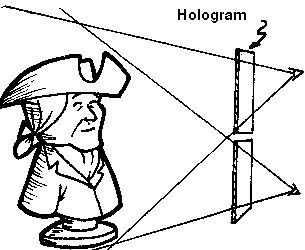
A hologram is any reproduced image that appears 3-dimensional as a result of a certain production process involving a split laser beam and a special photographic film (See Mechanics for more details on this process). For now, suffice to say that a hologram is a specific way to condense the information needed to view an object in 3-dimensions onto a 2-dimensional surface.
History
The theory of holography was developed by Dennis Gabor, a Hungarian physicist, in the year 1947. His work was originally intended to increase the resolving power of electron microscopes. However, Gabor proved his theory not with an electron beam, but with a light beam, and the result was the first hologram ever made. These early holograms were legible, but plagued with many imperfections because Gabor did not have a coherent light source capable of making crisp, clear images. It was not until the invention of the laser, which was first made to operate in 1960, that holograms as we know them today were born. For an explanation of why laser light is necessary for crisp holograms, see [link] the Mechanics section. Holographic technology has advanced greatly since the 60s, of course, but the fundamentals of the production process have remained mostly the same.
Windows to another dimension
Holograms can be very beautiful and very precise tools for visualizing a higher dimension using lower dimensional information. Of course, it is important to remember that a hologram does not contain all of the information about the 3-dimensional object it portrays. At present, the vast majority of holograms only show a portion of the full 360 degree rotation of the object. Looking at an ordinary flat hologram is comparable to looking at a stationary 3-dimensional object through a window-- you can see different views of it as you move around behind the window, but you canít see the other side of the object. Also, as with other windows, if you change the size of the window the object or objects you are viewing do not change their size.
All the information in each piece
One of the most fascinating and most often misunderstood facts about holograms is that if you break or cut a hologram into pieces, each piece will reveal a different view of the entire object. This makes some sense following our earlier window metaphor. If you chop the hologram in half you are in effect looking through a smaller window, so you see the entire object, but from a more restricted angle.

This phenomenon occurs because the light reflected from each point on the object is not focused to a single point on the film, but is allowed to spread out through space between the object and the film, covering a large portion of the film and interfering with the reference beam throughout that whole portion of the film. In this way, every point on the original object is coded into a large area of the hologram. Therefore, each small portion of the film contains information about the whole of the object. This property has turned out to be an incredibly resonant image for many thinkers. One imaginatively wacky paper goes so far as to claim that the universe is a hologram.
Also, several fiction writers have been inspired by this property of holograms. Consider the following passage from a short story entitled "Fragments of a Hologram Rose" by cyberpunk author William Gibson:
|
| ||
BACK |
|
NEXT |